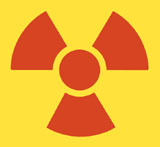 This section of the EHS website was developed to provide additional information and resources to those of you whose work involves exposure to radiation AND to those of you, including the general public, who do not work around radiation sources but would like to know a little bit about radiation.
This section of the EHS website was developed to provide additional information and resources to those of you whose work involves exposure to radiation AND to those of you, including the general public, who do not work around radiation sources but would like to know a little bit about radiation.
You will find the section on Radiological Emergency Response useful if you are interested in information and guidance regarding the risks and proper response associated with an emergency such as a terrorist event involving the use of radioactive material.
There is a wealth of information on radiation related topics available on the internet today. Rather than try to reproduce all of that information on this site, we have provided short discussions of various topics and then related links that will take you to sites which can provide you with all the information you are looking for (and more).
If you have any questions regarding any of this information, please feel free to contact our office at 434.982.4919.
There are many different types of radiation that we are all exposed to in our daily lives. Radio waves, visible light, microwaves; these are all types of radiation that are part of what is called the electromagnetic spectrum. X-rays and gamma rays, the type of radiation that most people think of when you talk about "radiation", are part of this electromagnetic spectrum as well. To start with the basics, visit the following sites:
Radiation Protection, NRC, United States
Radiation: Non-Ionizing and Ionizing, EPA, United States
X-rays, gamma rays and particulate radiation such as alphas, betas and neutrons are capable of creating ionization in matter and are called ionizing radiation. Ionization is a process in which an electron is removed from its orbit around the atom's nucleus, resulting in a positively charged ion and a free negative electron. Ionization in biological material can lead to damage of cells and biological systems in the body if a large enough dose of radiation is received by the body.
When we talk about radiation and radiation dose, we use special terms such as rad or rem. To understand dose and radiation measurement, you must have a basic understanding of what these words mean.
See here for information on Radiation Terms.
The biological effects from exposure to ionizing radiation depend on the amount and type of radiation you are exposed to. Not all radiation exposure is dangerous. We are all exposed to small amounts of radiation every day of our lives from naturally occurring radionuclides in the air, water, food and in the earth and building materials surrounding us. This radiation is called background radiation.
The current assumption in the radiation protection community at this time is that the risk of harmful effects from radiation increases with the amount of dose received. The Nuclear Regulatory Commission has set dose limits for radiation workers and the general public. The dose limit for a member of the general public is 100 mrem per year (not including exposure to natural background radiation). The whole body dose limit for a radiation worker is 5000 mrem per year. These limits are believed to be conservative and to represent very minimal risk for harmful effects.
See this website for a discussion of health effects associated with radiation exposure and associated risks.
Avoiding exposure to all radiation is impossible because of natural background radiation. Avoiding exposure to large or harmful amounts of radiation is fairly simple. If you remember these three words, you can keep your doses low.

Minimize the time you spend near the source of radiation Keep as much distance between you and the source as possible and use shielding if possible to stop the radiation. Go to this site for additional information on ways to minimize your radiation dose.